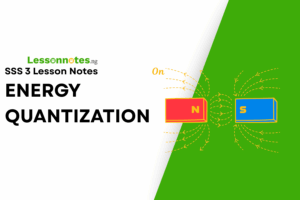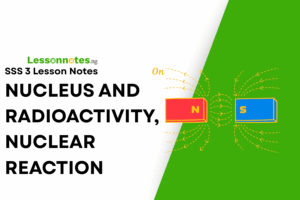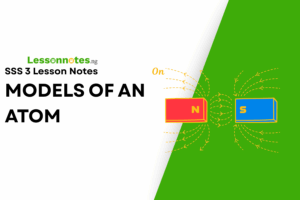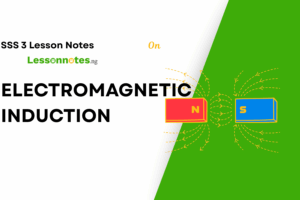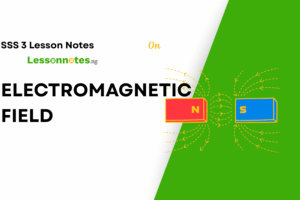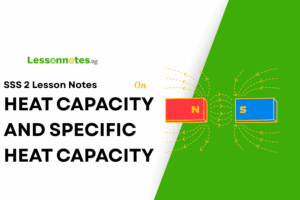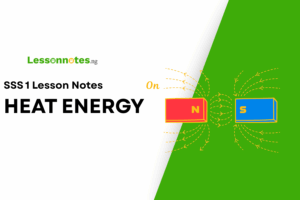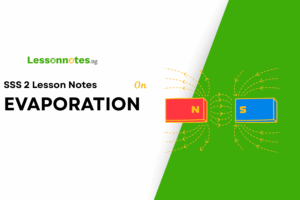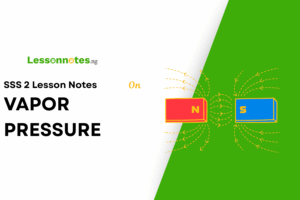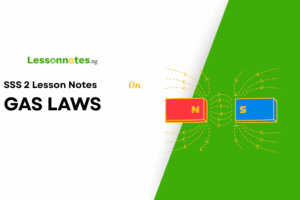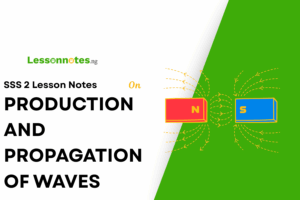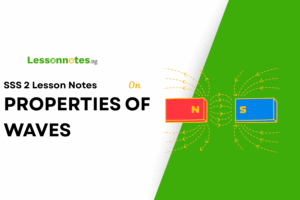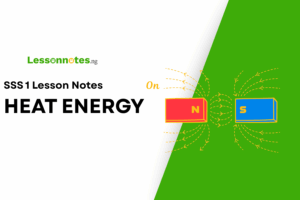Light Wave SS2 Physics Lesson Note
Download Lesson NoteTopic: Light Wave
Light waves are a visible source of energy. It is also a wave motion. It has a very short wavelength of 5×10-⁴mm. Light travels at a speed of 3.0×10⁸ms-1
SOURCE OF LIGHT WAVES
There are various sources of light: natural and artificial, luminous and non-luminous.
Natural sources of light include the sun and the stars. Artificial sources of light are candles, electric torches, electric lamps, incandescent, arc light and fluorescent light.
Self-luminous or luminous sources of light are those that generate and emit light by themselves e. g. the sun, stars, fireflies and some deep-sea fishes.
Non-luminous objects are seen when they reflect or throw back light from luminous objects. Examples of non-luminous objects are the moon, paper, mirror, wall etc.
When light falls on such surface, it may be absorbed, transmitted or reflected, sometimes a combination of the above processes may occur
LIGHT RAYS AND BEAMS
A ray is the direction of the path in which light is travelling. It is represented by a straight line with an arrowhead
————>———–
A beam is a collection of two or more rays of light. Beams can be parallel, convergent or divergent.
A parallel beam is two or more rays travelling in the same direction but can never intersect each other.
—————>———–
—————>———–
—————>———–
A beam of light is said to be convergent when they meet at a point.
The divergent beam occurs when a collection of light rays that have the same source is spread out apart.
RECTILINEAR PROPAGATION OF LIGHT
The phenomenon of light travelling in a straight line is known as rectilinear propagation of light. It can be demonstrated by placing a candle flame at the end of a straight pipe, the light of the flame will be seen clearly at the other side of the pipe. If the pipe is then bent and the process repeated, nothing will be seen at the other end, this clearly shows that light travels in a straight line.
Two natural effects that result from the rectilinear propagation of light are the formation of eclipse and shadow. The principle of operation of the pinhole camera also depends on the fact that light travels in straight lines.
SHADOW
A shadow is an area in which light rays from a source cannot reach. It is produced by the obstruction of light by an opaque object. There are two types of shadow: partial (penumbra) shadow and total (umbra) shadow.
If the light source is large, the shadow formed consists of two parts, a completely dark area known as the umbra and an outer gray area known as the penumbra or partial shadow. In the umbra region, the light from the source is completely blocked by the opaque body. In the penumbra region, the light is partially blocked by the opaque object. The inner region of the shadow receives less than the outer parts. Thus the penumbra becomes brighter from the umbra and outwards.
ECLIPSE
An eclipse is a result of a shadow cast by one heavenly body on another. The sun is a luminous body and it is in the middle while the earth and the moon revolve around the sun. If the moon is between the sun and the earth, the shadow of the moon will be cast on the earth’s surface.
There are two types of the eclipse:
- Eclipse of the sun (solar eclipse): here the moon comes between the sun and the earth in a straight line
ii, Eclipse of the moon (lunar) eclipse: in this case, the earth comes in between the sun and the moon.
PINHOLE CAMERA
It consists of a lightproof box, one end of which has a small hole made with a pin or needlepoint. The opposite end has a screen made with tracing paper or ground glass. Light from an object in front of the pinhole passes through it and forms an image on the screen. If the screen is replaced with photographic paper or film, a picture of the object can be taken with the pinhole camera.
When using the pinhole camera to take pictures of an object, long exposure is necessary to allow sufficient light to enter the box through the pinhole. The image formed on the screen of the pinhole camera will be seen more clearly if external light is excluded by covering the head and camera with a dark cloth.
The image formed on the screen of the pinhole camera is inverted
Linear magnification.
Magnification is defined as the ratio of the size (or height) of the image to the size (or height) of the object
Image magnification=
image size = image distance
object size object distance
i.e M = hi = v
ho u
REFLECTION OF LIGHT WAVES
Reflection is the bouncing back of light waves when it strikes a surface.
Reflection of plane mirrors.
There are two types of reflection:
- Regular Reflection
- Diffuse Reflection or Irregular
Reflection
In regular reflection, parallel rays of light incident on a smooth or polished surface are reflected as parallel rays in one direction.
In diffused or irregular reflection, parallel rays of light incident on a rough or irregular surface are reflected in various directions
LAWS OF REFLECTION
The first law of reflection states that the incident ray, the reflected ray and the normal at the point of incidence all lie on the same plane
The second law of reflection states that the angle of incidence (i) is equal to the angle of reflection (r).
IMAGE FORMATION BY A PLANE MIRROR
Characteristics Of Image Formed By Plane Mirror
i. It is the same size as the object
ii.It is virtual
iii. It is laterally inverted
iv. It is upright
v. It is far behind the mirror as the object is in front of the mirror.
IMAGE
There are two types of images:
- Real image
- Virtual image
A real image can be caught on a screen. Light rays pass through real images. A virtual image cannot be caught on a screen. It is one through which rays do not pass but which are nevertheless visible.
LATERAL INVERSION
The effect of a plane mirror on objects placed in front of it whereby the appearance of the image looks like a reversal of the object is known as lateral inversion.
IMAGES FORMED BY INCLINED MIRROR
When two mirrors are placed at an angle to each other, the number of images formed is given by:
n = 360 – 1
Ө
N = Number of images
Ө = Angle of inclination
When Ө = 180°, the two mirrors will act as a single mirror and therefore form only one image. When Ө = O, the two mirrors are parallel to each other and the image of the object placed between them will be at infinity.
EFFECT OF MIRROR ROTATION ON REFLECTED RAY-MIRROR GALVANOMETER
If the direction of an incident ray on a mirror is kept constant and the mirror is rotated through twice that angle. This fact is utilized in mirror galvanometers (to measure very small electric current) and in the navigator’s sextant.
Example
The reflection of a narrow beam of light incident normally on a plane mirror falls on a meter rule parallel to the mirror and at a distance of 1m. Calculate the angle of rotation of the mirror if the reflected beam is displaced 21.26cm along the meter rule when the mirror rotates.
Solution:
Angle ONP = 2 Ө
Tan 2 Ө = 21.26
100
= 0.2126
2 Ө = tan-1 (0.2126)
2 Ө = 120
Ө = 60
USES OF PLANE MIRROR
- It is used in periscope
- It is used in kaleidoscope
- It is used in sextant
REFLECTION OF CURVED MIRRORS
Curved mirrors differ in size, shape and direction of their curvature. In respect of shape, we have spherical and parabolic mirrors.
There are two types of spherical mirrors – concave and convex mirror
- Concave mirrors – the concave mirrors are hollowed out toward the incident light like the inside surface of a spoon. It is also called a converging mirror.
- Convex mirrors – these mirrors bulge towards the incident light like the back of a spoon. Convergent mirrors are also referred to as divergent mirrors.
TERMS USED WITH SPHERICAL MIRRORS
- The pole (p) – this is the midpoint of the spherical mirrors
- The aperture – this is the width or diameter of the mirror.
- The centre of curvature (c) – this is the centre of the large sphere from which the spherical mirror is carved out
- The radius of curvature (R) – this is the distance between the centre of curvature and the pole of the mirror.
- The principal axis – this is the imaginary line passing through the pole (p) and the centre of curvature (c)
- The principal focus (f) – this is the point on the principal axis where the incident rays converge (for concave mirrors) or appear to diverge (for convex mirrors)
- Focal length (f) – this is the distance between the focus and the pole of the spherical mirror. It is always half of the radius of curvature
f = R/2
R = 2F
SPHERICAL ABERRATION
This is the phenomenon whereby a spherical mirror of a wide aperture cannot bring all parallel rays to the same focus. To avoid this, spherical mirrors of a small aperture are usually used. This is also why parabolic mirrors are used in place of spherical mirrors in searchlights and car headlamps.
CONSTRUCTION OF RAY DIAGRAMS
The following tips are used in constructing ray diagrams:
- Light rays parallel to the principal axis are reflected through the focus
- A light ray passing through the centre of the curvature is reflected along the same path
- A light ray passing through the focus is reflected parallel to the principal axis
- Light rays striking the mirror at the pole are reflected such that the angle of incidence is equal to the angle of reflection
CHARACTERISTICS OF IMAGE FORMED BY CONCAVE MIRRORS
- Object before the centre of curvature: the image formed is:
- same size the object
- between the centre of curvature and the focus
- inverted
- real
- Object at the centre of curvature: the image formed is:
- same size the object
- at the centre of curvature
- inverted
- real
- Object between the centre of curvature and the focus: the image formed is:
- Magnified
- Beyond the centre of curvature
- Inverted
- real
4. Object at focus: the image formed is:
- Formed at infinity
- Object between focus and the pole: the image formed is
- Magnified
- Behind the Mirror
- Virtual
- Erect
- Object at infinity: the image formed is:
- Diminished
- Formed at the focus
- Real
- Inverted
- Characteristics of the image formed by convex mirrors:
The image formed by a convex mirror is always virtual, erect and diminished in size; it is formed between the pole and the principal focus. This is unlike the case of the concave mirror which can produce either real or virtual images that may be inverted or erect, magnified or diminished in size according to the position of the object.
LINEAR MAGNIFICATION
This is defined as the ratio of the image size to the object size
image size = image distance
object size object distance
i.e M = hi = v
ho u
Mirror formula
The focal length, f, object distance, u, and the image distance, v, can be related using the formula below:
1 + 1 = 1
u v f
SIGN CONVENTION
This is used to know and calculate by properly assigning signs to all the parameters used in the mirror
- The new Cartesian – here, all the distances measured to the left of the mirror from the pole are negative while distances measured to the right of the mirror from the pole are positive.
- Real is positive and virtual is negative – this is the most widely accepted and used in calculations for mirrors and lenses. In this case:
- All distances are measured from the pole of the mirror to either left or right.
- The distance between real objects and real images is positive.
- The distance between virtual objects and virtual images is negative.
- The focal length of a concave mirror is positive while the focal length of a convex mirror is negative
Example
An object which is 5.0cm high is placed 10.0cm in front of a convex mirror of focal length 15.0cm. Find the position, size and nature of the image produced.
Solution
Using “real is positive”
Given that f=-15cm, u=10cm
1 + 1 = 1
u v f
= 1 + 1 = -1
10 v 15
= 1/v = -(5/30)
= V = 6cm
For magnification
m = v/u
m = -(6/10)
m = -0.6
Image size = magnification × object size (height)
Image size = 0.6 × 5.0 = 30cm
Thus, the image is formed 6.0cm behind the mirror and the height is 3.0cm. It is erect, virtual, diminished
ASSIGNMENT
- Give the differences between a real and a virtual image
(b) A magnified, virtual image is formed 12cm from a concave mirror of a focal length of 18cm. Calculate the position of the object and the magnification of the image
- Explain with the aid of a diagram how the image of an object is formed by a plane mirror
(b) State four characteristics of the image
- Define the following terms (i) principal focus (ii) radius of curvature (iii) principal focus
(b) The screen of a pinhole camera is a square of 160mm and it is 150mm behind the pole. The camera is placed 11m from a flagstaff and positioned so that the image of the flagstaff is formed centrally on the screen. The image occupies three-quarters of the screen. What is the length of the staff?


